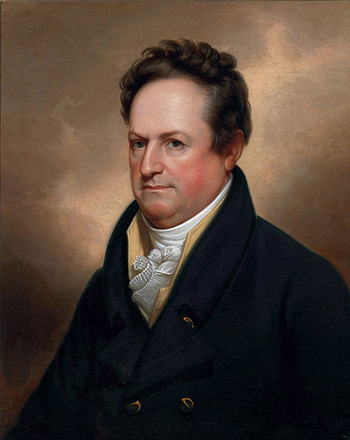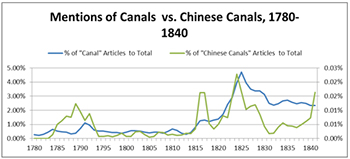What do you do when you can’t stop yourself from falling into a ditch?
In my case it was “Clinton’s Ditch”—better known as the Erie Canal, opened in 1825. It seemed that every time I went to America’s Historical Newspapers to research my dissertation—I write on the politics of early American trade with China—every query, no matter how carefully constructed, returned discussions of canals. With every “search” button clicked, I felt De Witt Clinton (he of “Ditch” fame) drag me a step more away from the salty tea-clippers at Canton, and further into the freshwater depths of the New York backcountry, yammering all the way about locks, average elevations, and the glorious future of the wheat flour trade.

oil on canvas, 28 5/8 x 23 3/8, 1823, Wikimedia.org)
Clinton, a political impresario who served as a U.S. Senator, mayor of New York City, and Governor of New York State, was the chief force behind the creation of the Erie Canal, the new nation’s most ambitious and successful infrastructure project. In the early nineteenth century, waterways were the quickest and most reliable way to move freight. Unfortunately, nature did not always provide—but building canals to the hinterland, it was thought, would shrink the distance between pioneer farmers in the West and the hungry urban markets of the East. Boosters predicted that new canals would create a virtuous cycle of agricultural expansion, population growth, and increasing wealth—a recipe for national greatness.
Promoters like Clinton competed to secure these blessings for their own localities, creating a massive boom in canal construction across the U.S. during the 1820s and 1830s—the first of many such infrastructure booms which defined the development of the American economy (see: railroads, highways, and fiber optic cables).
Canals are thus central to the story of American development; and so I could not resist investigating why early Americans, seemingly so focused on these local projects, were simultaneously preoccupied with a subject as distant and foreign as China.
Soon I found that my errant results were actually quite consistent. 1Canal-related items appeared in my searches for Chinese “trade” and “commerce” because Americans were fascinated by the positive effect China’s canal network had on domestic prosperity. In other words, while I was looking for articles about American trade with China, I was turning up discussions of how trade in China was important to Americans.
Mentions of canals in general and Chinese canals in particular appear to have taken off in the early years of the canal construction boom—after the War of 1812, when legislatures were debating canal proposals. Judging from a sampling of this pool of articles, Americans thought that China’s status as one of the “most industrious and most prosperous nations on the face of the earth” was intimately tied to its extensive canal network. 2
However, these were not the first appearances of China’s canals in American print culture; indeed, they first entered it as curios, appearing in descriptive articles sourced to the writings of 18th-century French Jesuit sinologists.3 The Pennsylvania Herald’s 1786 excerpt from Le Comte’s Description of China is typical: canals appear alongside other notable architecture, like the “China tower” temple at Nanjing and the Great Wall.
Of all the public works in China, none do the people such honour as their canals and bridges; nor is any thing more worthy of the attention of the curious. By means of these canals the whole trade of the empire is carried on, with the advantage of water carriage, and in this manner one may travel from Canton, the most southern city, to Pekin the most northern, without travelling above one day by land. 4
Gradually, China’s canals became more than exotica. The most widely reproduced source for this new wave of practically-oriented canal writing was John Philips’s General History of Inland Navigation, where China’s canals assumed pride of place in political economy. Claiming that “scarcely a town or even a village, … has not the advantage either of an arm of the sea, a navigable river, or a canal,” Philips argued that “China owes the greatest part of its riches and fertility to these numerous canals, which are of the greatest utility for the transportation of the produce and merchandize of one province to another...” 5
There were, of course, deviations from this theme: some publications reproduced Adam Smith’s account of the consequences of overpopulation in China, where canals were a setting for the poverty of the “many thousand families [which] have no habitation on the land.” 6But such detours were rare. For decades, China’s canals largely appeared in the American press as examples of administrative genius and the means to extraordinary agricultural prosperity. They were thus the perfect data for quasi-physiocratic agriculturalists interested in building a prosperous nation free of overseas entanglements: precisely the project of many American writers, particularly, though not exclusively, those among the Jeffersonian Republicans.
In the hands of American polemicists, China’s canals rebutted European pretentions. Though the canals of the Netherlands, France, and England were also noted, their relative youth and small extent, compared to those of the Chinese, were emphasized. As a 1792 bulletin in a Philadelphia paper put it:
“Inland navigation seems a favorite pursuit of the present age... . Chinese have led the way in such improvements, their whole empire being intersected in every direction by highways of this kind, generally deep enough to float vessels of two or three hundred tons burden. The Europeans have imitated these ingenious Asiatics...” 7
In the realm of canals, as in many other areas, China was useful to Americans precisely because it was not Europe.
China and its canals were used to defend specific policies, too. Jefferson’s unpopular Embargo, for example, was lauded by one lonely Rhode Island supporter for enabling “roads [to be] improved and increased; numerous and extensive bridges built; and canals formed and established for rendering these United States, of late doubled in extent of territory, like China, almost a world within themselves, and in fact, as well as name, independent.” 8
This move to compare the U.S. and China was a common one, but not without its dangers. Even devotees of internal improvements worried about the implications of China’s example. Considering the Chinese experience, an otherwise enthusiastic supporter noted that canals “are alike the links of friendship and the means of prompt coercion.” Though they promoted a “facile intercourse” that encouraged unity, canals’ easy means of travel also provided the central government with “the means of conveying an army and its apparatus,” such that any “rebellion or insurrection may be nipt in the bud.” The author fretted that the “easy and willing obedience” canals encouraged made them too dangerous to be deployed in a republic. 9
Objections to expanding federal authority did, in the end, prevent internal improvements from becoming a project of the early national government. Nonetheless, canal projects proceeded apace as state-run efforts, knitting the country together sufficiently to create a quantitative revolution in transport that in turn produced a qualitative difference in the way Americans felt themselves included (or ensnared) in market economies.
The debate over funding the Erie Canal, in 1816 and 1817, illustrates just how deeply China’s canals had been integrated into the political imagination. The project’s major backer, my friend De Witt Clinton, invoked China’s network on the very first page of his major pro-canal pamphlet. 10 Even disagreements over the mere details of Chinese canals were enough to start a newspaper fracas during the passage of the canal appropriation bill. “A Small Blunder Exposed!” crowed the headline in the New-York Columbian above a report on an exaggeration made in the anti-canal National Advocate about the number of laborers needed to cut the Chinese Grand Canal (thirty thousand vs. thirty million). 11
It was no accident, then, that when observers of the work on New York’s canal reached for language to describe the project’s greatness, they stuck to what had become familiar from decades of use: “The New-York Grand Canal, when finished, will rank next to the Grand Canal of China.” 12
In later years, after many canals were built and a more direct knowledge of Asia established, new dynamics dominated Americans’ understanding of China, and mentions of China and canals, together, decreased. But the early link was an influential one—an index not only of Americans’ extensive and uneven perception of the world and its parts, but also of their ambition to adopt, and then transcend, the greatest of its marvels.
Footnotes:
1 After some experimentation, I found that the following query generated the greatest number of accurate results: a full-text search for “(China OR Chinese) NEAR50 (canal OR canals)” with the article types limited to News/Opinion, Election Returns, Letters, Poetry and Legislative Acts or Legal Proceedings in order to exclude advertisements. The data from these searches was used to create the included chart.
2 DeWitt Clinton, Remarks on the proposed canal, from Lake Erie to the Hudson River. By Atticus, Early American Imprints, Series 2, no. 38779 (filmed) (New-York: Printed by Samuel Wood & Sons, 1816), 3.
3 The mainstays were the French Jesuits Louis Le Comte (who had served in China) and Jean-Baptiste Du Halde (who never did, but wrote a superbly influential history of the Chinese Empire anyway). See, for example: "A Description of China, by Lewis L' Compte, with an Account of the Customs and Manners of Its Inhabitants," Pennsylvania Herald(Philadelphia, PA), 19 July 1786; "Extracts from the Travels of a Philosopher," Massachusetts Gazette, 19 June 1787; "Extract from a General Description of China, lately published," Massachusetts Centinel, 29 Sept 1787 ; "From a late London paper: Embassy to China,"Independent Gazetteer (Philadelphia, PA), 25 October 1794.
4 "A Description of China, by Lewis L' Compte, with an Account of the Customs and Manners of Its Inhabitants," Pennsylvania Herald (Philadelphia, PA), 19 July 1786
5 John Philips, A general history of inland navigation, foreign and domestic: containing a complete account of the canals already executed in England, with considerations on those projected (London: I. and J. Taylor, 1792), 6, 9.





